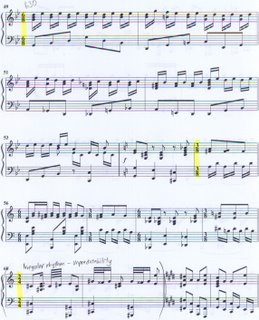Fig a

From bar 29 (or 0’43) onwards, the music seemed to intensify a little as a result of punctuation in the bass. From here onwards, the rhythmic pattern (shown in Fig b) which can be detected throughout the piece is first presented.
Fig b

The semiquavers in the 2nd beat seemed to propel the music forward. This rhythmic pattern is also a unifying feature which helps bind the entire work together.
From bar 42 onwards, the sense of beat/ pulse is not as clear as before because there are frequent changes in the time signature to irregular meters such as 7/8, 5/8, 3/8. This coupled with the use of more irregular rhythms such as seen in (bar 60, 126), changes in tempo and usage of firmata, gives the music a sense of unpredictability and unevenness which well matches the musical effect of eeriness and eccentricity portrayed by the animation.
Bars 42-48




1 comment:
Hi jr,
Great piece of music chosen to examine, and you quite rightly chose to focus on the rhythmic aspect as opposed to the harmonic which may be tricky for you at this stage.
Re Fig. a, there seems to be a kind of cross-rhythmic grouping where the RH pattern is 2+2+2 and the LH is 3+3.
The changing time signatures at bs. 42ff is interesting, would you like to go one step further by commenting on the rhythmic effects in terms of our perception of the pulse (granted that the element of unpredictability is one aspect of the result). BTW, 3/8 is not an irregular meter.
Post a Comment